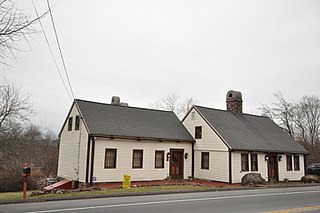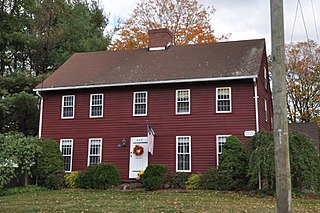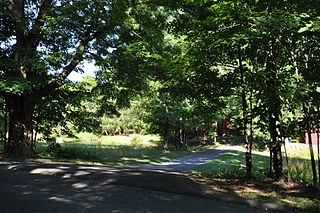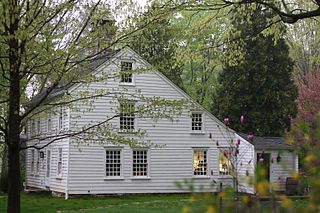
The Captain Seth Chandler House is a historic house in the East Woodstock section of Woodstock, Connecticut. With a construction history dating to 1760, it has a number of unusual features and form for a rurally sited house of that period, including unusually fine stonework in the chimney and stencilled plaster. The house was listed on the National Register of Historic Places in 1993.

The Whitehall Mansion is a historic house at 42 Whitehall Avenue in the Stonington side of Mystic, Connecticut. Built about 1771 for a local physician and politician, it is a fine example of late Georgian architecture. It has been moved twice, both times short distances, and now serves as a bed and breakfast inn. The house was added to the National Register of Historic Places on April 12, 1979.

The Samuel Farnsworth House is a historic house at 537 Mountain Road in West Hartford, Connecticut, United States. Probably built about 1797, it is one of West Hartford's few surviving 18th-century buildings, and a particularly rare example of a small vernacular single-story cottage. The house was listed on the National Register of Historic Places on September 10, 1986.

847 North Main Street in West Hartford, Connecticut, is one of the town's few surviving 18th-century houses. Dating to the mid-18th century, it is a well-preserved example of vernacular Georgian architecture, with a modest entrance surround. The house was listed on the National Register of Historic Places on September 10, 1986.

The Samuel Smith House is a historic First Period house at 82 Plants Dam Road in East Lyme, Connecticut. With a construction history dating to about 1700, it is one of the oldest buildings in the community, exhibiting a pattern of architectural changes over the 18th century. The house was added to the National Register of Historic Places on June 4, 1979.

The John Glover House is a historic house at 53 Echo Valley Road in Newtown, Connecticut, USA. Built about 1708 by an early town settler, it is a remarkably well-preserved example of 18th-century residential architecture, owned for generations by a locally prominent farming family. The house was listed on the National Register of Historic Places in 2001.

The Josiah Bronson House is a historic house on Breakneck Hill Road in Middlebury, Connecticut, built about 1738. It is one of the town's few surviving 18th-century houses, and a good example of residential architecture from that period. It was listed on the National Register of Historic Places in 1982.

The Clymer House is a historic house at 31 Clymer Road in Harrisville, New Hampshire. Built in 1932, it is a finely crafted example of Colonial Revival architecture, built in conscious imitation of an earlier form that might have occupied the same site. The house was listed on the National Register of Historic Places in 1988.

The Hewitt House is a historic house on United States Route 4 in Enfield, New Hampshire. Built in 1871, it is a particularly fine example of late Italianate architecture, built for the manager of local woolen mills. The house was listed on the National Register of Historic Places in 1985, and included in the Enfield Village Historic District in 2010.

The William Peabody House is a historic house on North River Road in Milford, New Hampshire. This 2+1⁄2-story wood-frame house was built c. 1740 by William Peabody, the first English settler of the Milford area, and remains a good example of Georgian residential architecture despite a 1973 fire. The house was listed on the National Register of Historic Places in 1979.

The Haven-White House is a historic house at 229 Pleasant Street in Portsmouth, New Hampshire. Built about 1800 for a prosperous merchant, it is an important early example of the city's Federal architecture, with numerous high-quality interior features, and a rare surviving period stable. The property was listed on the National Register of Historic Places in 1985.

The Avery Clark House is a historic house at 1460 Meriden Avenue in Southington, Connecticut. Built about 1792, it is one of the town's surviving 18th-century houses, and well-preserved example of late Georgian vernacular architecture. It was listed on the National Register of Historic Places in 1989.

Dr. Henry Skelton House is a historic house at 889 South Main Street in Southington, Connecticut. Built about 1748, it is a well-preserved example of colonial Georgian architecture. It was listed on the National Register of Historic Places in 1989.

The Gordon Loomis House is a historic house at 1021 Windsor Avenue in Windsor, Connecticut. Built in 1835, it is a good local example of transitional Federal-Greek Revival architecture executed in brick. It was listed on the National Register of Historic Places in 1988.

The Samuel Hayes II House is a historic house at 67 Barndoor Hill Road in Granby, Connecticut. Probably built in 1769, it is an extremely rare example in the Connecticut River valley of a middle-class colonial house with a hip roof. It was listed on the National Register of Historic Places in 1992.

The Judah Holcomb House was a historic house at 257 North Granby Road in Granby, Connecticut, Built in 1776, it was a well-preserved example of late Georgian architecture, notable for its elaborate entry surround and its wealth of interior woodwork. It was listed on the National Register of Historic Places in 1988.

The Samuel Beach House is a historic house at 94 East Main Street in Branford, Connecticut. Built about 1790, it is one of the town's modest number of surviving 18th-century houses. It was listed on the National Register of Historic Places in 1988.

The Howd-Linsley House is a historic house at 1795 Middletown Avenue in the Northford area of North Branford, Connecticut. Built in 1705, it is a candidate as the oldest surviving building in the town, and a good example of period residential architecture. It was listed on the National Register of Historic Places in 1986.

The Ives-Baldwin House is a historic house at 474 Baldwin Avenue in Meriden, Connecticut. Built about 1798, it is a well-preserved example of a late 18th-century farmhouse, a rare property type in the now largely industrial town. It was listed on the National Register of Historic Places in 2003.

The Enos Kellogg House is a historic house at 210 Ponus Avenue Extension in Norwalk, Connecticut. Built about 1784, it is a well-preserved example of a late-18th century post-colonial saltbox style house. It was listed on the National Register of Historic Places in 2012.






















